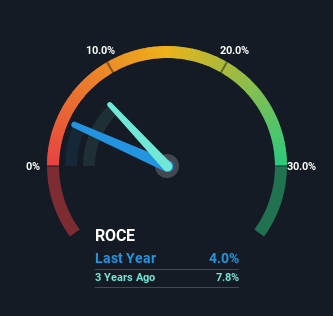- China
- /
- Electrical
- /
- SHSE:603115
Nantong Haixing Electronics (SHSE:603115) Is Reinvesting At Lower Rates Of Return

To find a multi-bagger stock, what are the underlying trends we should look for in a business? Firstly, we'd want to identify a growing return on capital employed (ROCE) and then alongside that, an ever-increasing base of capital employed. Put simply, these types of businesses are compounding machines, meaning they are continually reinvesting their earnings at ever-higher rates of return. In light of that, when we looked at Nantong Haixing Electronics (SHSE:603115) and its ROCE trend, we weren't exactly thrilled.
What Is Return On Capital Employed (ROCE)?
If you haven't worked with ROCE before, it measures the 'return' (pre-tax profit) a company generates from capital employed in its business. Analysts use this formula to calculate it for Nantong Haixing Electronics:
Return on Capital Employed = Earnings Before Interest and Tax (EBIT) ÷ (Total Assets - Current Liabilities)
0.04 = CN¥79m ÷ (CN¥2.3b - CN¥363m) (Based on the trailing twelve months to September 2023).
Therefore, Nantong Haixing Electronics has an ROCE of 4.0%. In absolute terms, that's a low return and it also under-performs the Electrical industry average of 6.5%.
Check out our latest analysis for Nantong Haixing Electronics

Historical performance is a great place to start when researching a stock so above you can see the gauge for Nantong Haixing Electronics' ROCE against it's prior returns. If you want to delve into the historical earnings , check out these free graphs detailing revenue and cash flow performance of Nantong Haixing Electronics.
The Trend Of ROCE
In terms of Nantong Haixing Electronics' historical ROCE movements, the trend isn't fantastic. Around five years ago the returns on capital were 18%, but since then they've fallen to 4.0%. On the other hand, the company has been employing more capital without a corresponding improvement in sales in the last year, which could suggest these investments are longer term plays. It may take some time before the company starts to see any change in earnings from these investments.
On a side note, Nantong Haixing Electronics has done well to pay down its current liabilities to 16% of total assets. That could partly explain why the ROCE has dropped. What's more, this can reduce some aspects of risk to the business because now the company's suppliers or short-term creditors are funding less of its operations. Since the business is basically funding more of its operations with it's own money, you could argue this has made the business less efficient at generating ROCE.
The Bottom Line On Nantong Haixing Electronics' ROCE
Bringing it all together, while we're somewhat encouraged by Nantong Haixing Electronics' reinvestment in its own business, we're aware that returns are shrinking. Since the stock has declined 12% over the last three years, investors may not be too optimistic on this trend improving either. In any case, the stock doesn't have these traits of a multi-bagger discussed above, so if that's what you're looking for, we think you'd have more luck elsewhere.
If you'd like to know more about Nantong Haixing Electronics, we've spotted 3 warning signs, and 2 of them make us uncomfortable.
If you want to search for solid companies with great earnings, check out this free list of companies with good balance sheets and impressive returns on equity.
Valuation is complex, but we're here to simplify it.
Discover if Nantong Haixing Electronics might be undervalued or overvalued with our detailed analysis, featuring fair value estimates, potential risks, dividends, insider trades, and its financial condition.
Access Free AnalysisHave feedback on this article? Concerned about the content? Get in touch with us directly. Alternatively, email editorial-team (at) simplywallst.com.
This article by Simply Wall St is general in nature. We provide commentary based on historical data and analyst forecasts only using an unbiased methodology and our articles are not intended to be financial advice. It does not constitute a recommendation to buy or sell any stock, and does not take account of your objectives, or your financial situation. We aim to bring you long-term focused analysis driven by fundamental data. Note that our analysis may not factor in the latest price-sensitive company announcements or qualitative material. Simply Wall St has no position in any stocks mentioned.
About SHSE:603115
Nantong Haixing Electronics
Manufactures and sells electrode foils for aluminum electrolytic capacitors in the People’s Republic of China.
Flawless balance sheet with proven track record.
Market Insights
Community Narratives




